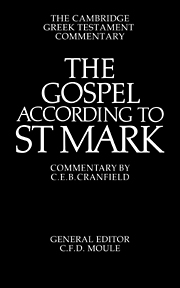Book contents
- Frontmatter
- Preface by the General Editor
- Contents
- List of Abbreviations
- Acknowledgements
- INTRODUCTION
- NOTES
- I THE BEGINNING
- II BEGINNINGS OF THE GALILEAN MINISTRY
- III LATER STAGES OF THE GALILEAN MINISTRY
- IV JESUS GOES OUTSIDE GALILEE
- V THE WAY TO JERUSALEM
- VI MINISTRY IN JERUSALEM
- VII THE PASSION
- VIII THE RESURRECTION
- SUPPLEMENTARY NOTES
- REVISED ADDITIONAL SUPPLEMENTARY NOTES
- Addenda
- Index
V - THE WAY TO JERUSALEM
Published online by Cambridge University Press: 15 March 2010
- Frontmatter
- Preface by the General Editor
- Contents
- List of Abbreviations
- Acknowledgements
- INTRODUCTION
- NOTES
- I THE BEGINNING
- II BEGINNINGS OF THE GALILEAN MINISTRY
- III LATER STAGES OF THE GALILEAN MINISTRY
- IV JESUS GOES OUTSIDE GALILEE
- V THE WAY TO JERUSALEM
- VI MINISTRY IN JERUSALEM
- VII THE PASSION
- VIII THE RESURRECTION
- SUPPLEMENTARY NOTES
- REVISED ADDITIONAL SUPPLEMENTARY NOTES
- Addenda
- Index
Summary
With the account of Peter's confession of Jesus as the Messiah and the first prediction of the Passion the second half of the gospel begins. Henceforth Jesus addresses his teaching to the disciples rather than to the crowds. This division describes the journey from the neighbourhood of Gaesarea Philippi to Jerusalem, and the main groups of material are introduced in turn by brief geographical notes (viii. 27, ix. 30, x. 1, 32).
PETER'S CONFESSION AND THE FIRST PREDICTION OF THE PASSION (viii. 27–33)
(Mt. xvi. 13–23: Lk. ix. 18–22)
For Bultmann vv. 27–30 are a ‘faith-legend’ expressing the Christian community's confession and v. 31 is similarly secondary, the creation of tne early Church. The original ending of the legend of Peter's confession is preserved, he thinks, in Mt. xvi. 17–19, and has been replaced by Mark by ‘a polemic against the Jewish-Christian position represented by Peter from the standpoint of the Hellenistic Christianity of the Pauline sphere’. Against this view it may fairly be pointed out that ‘The reference to “the villages of Caesarea Philippi” by a writer who so rarely gives placenames commands respect’ (Taylor) (Bultmann's attempt to separate the mention of Caesarea Philippi from vv. 27–30 and to fasten it to vv. 22–6 is unconvincing); the connection with the Transfiguration (ix. 2) seems to be pre-Markan and is precise; the picture of Peter in vv. 27–33 is life-like and suggests Peter's own reminiscence; the fact that Jesus does not confirm the confession is surely significant; and the question asked by Holl: ‘Who from the primitive community would have dared to call the revered Kephas Satan?’
- Type
- Chapter
- Information
- The Gospel according to St MarkAn Introduction and Commentary, pp. 266 - 346Publisher: Cambridge University PressPrint publication year: 1959
- 1
- Cited by



